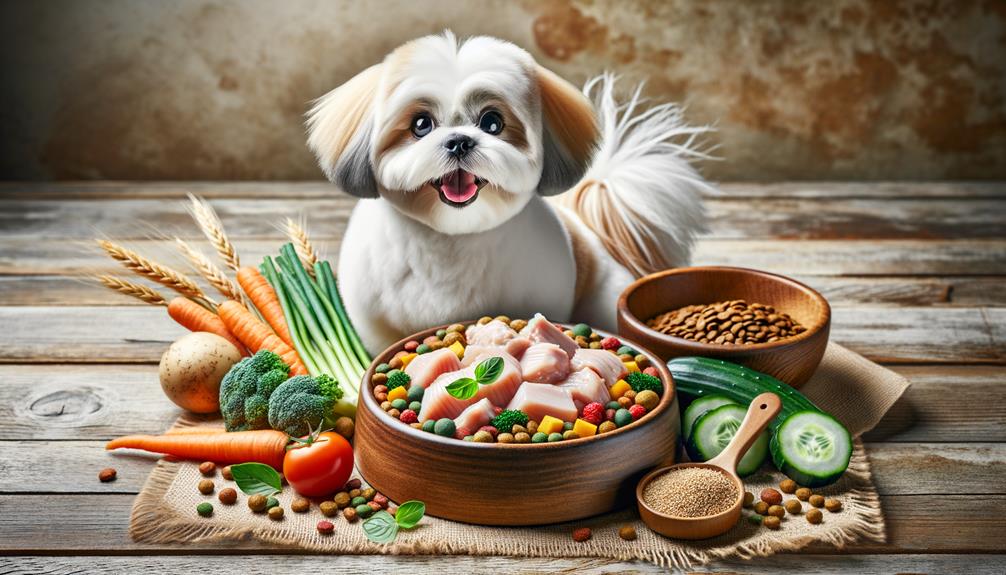You've likely noticed an uptick in homemade dog food recipes lately, haven't you? Particularly those featuring chicken as a main ingredient. It's not just a fad, there's a valid reason behind this trend. Homemade dog food, especially those with high-quality protein sources like chicken, can be a nutritious alternative to commercial dog food. But it's not as simple as tossing some chicken into a bowl. There are safety measures, preparation techniques, and recipe variations to consider. Curious about how to get it right? Let's explore this further.
Key Takeaways
- Homemade dog food recipes with chicken offer lean protein and can be tailored for specific dietary needs.
- Recipes such as Chicken and Rice Medley, Chicken and Vegetable Stew, and Chicken, Sweet Potato, and Apple Mix are nutritious options.
- Ensure to use high-quality, fresh chicken and cook it thoroughly to maintain safety.
- Avoid harmful seasonings like onions and garlic and opt for beneficial ingredients like peas, carrots, sweet potatoes, and apples.
- Rotate these recipes to provide a balanced diet and consult with a vet for any dietary changes.
Understanding Canine Nutrition
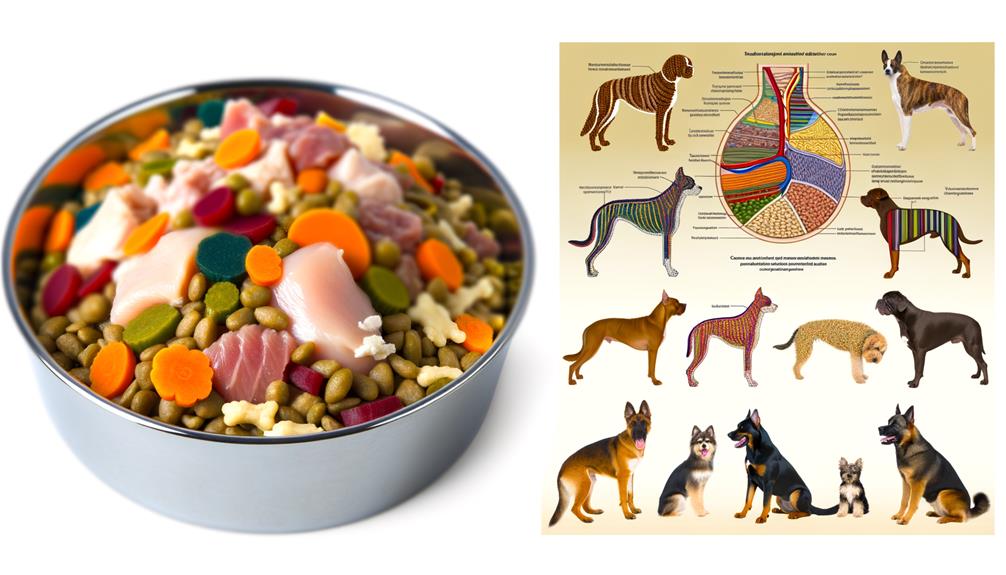
Before diving into chicken dog food recipes, it's crucial for you to grasp the basics of canine nutrition. Your furry friend's health largely depends on the food they eat. Consider canine obesity, a common issue among dogs, primarily stemming from overfeeding and lack of exercise. With the right diet, you can help your dog maintain a healthy weight and stay active.
When designing your dog's menu, it's important to remember that not all foods suitable for humans are safe for dogs. Certain dietary restrictions apply. Foods like chocolate, grapes, and onions can be harmful to dogs and should be avoided. Instead, focus on proteins, carbohydrates, and healthy fats. Chicken, for example, is a great source of lean protein that can be a staple in your homemade dog food recipes.
However, nutrition isn't just about what to include in your dog's diet, but also about balancing the quantities. Overloading on protein can lead to weight gain and other health issues, while too little might leave your dog malnourished. It's about finding the right balance.
Remember, dogs are individuals just like us, with their own dietary needs and restrictions. Some dogs might need a low-fat diet to manage weight, while others might require more protein for their active lifestyle. It's always best to consult with your vet before making any significant changes to your dog's diet.
In the end, understanding canine nutrition isn't just about preventing obesity or adhering to dietary restrictions. It's about providing your pet with a balanced, nutritious diet that keeps them healthy and happy.
Benefits of Homemade Dog Food
You're probably wondering why you should bother making homemade dog food.
Well, there are several health benefits your dog can gain from eating homemade meals.
Plus, it's easier than you think to maintain a nutritional balance in your recipes.
Health Advantages of Homemade
While it's tempting to simply rely on store-bought dog food, making your own homemade chicken dog food has numerous health advantages for your furry friend. One of the most significant benefits is combating dog obesity. Store-bought foods often contain fillers and additives that can contribute to weight gain. By making your own food, you have full control over the ingredients, helping you maintain your dog's weight.
Another great advantage is food customization. This isn't just about picking flavors your dog loves, but also about tailoring the diet to their unique health needs. If your dog has allergies, sensitive stomach, or specific dietary requirements, homemade food allows you to adjust the recipe accordingly.
Nutritional Balance in Recipes
When crafting homemade dog food, it's crucial to ensure a balanced nutritional content for your pup's overall health and vitality. Balancing macronutrients – proteins, fats, and carbohydrates – is key. Chicken, being a lean protein, is a great choice, but don't forget to include healthy fats and carbohydrates for energy.
Raw feeding can offer benefits such as fresher ingredients and improved digestion. However, it isn't without cons. Potential risks include bacterial infections and an unbalanced diet if not carefully planned. It's critical to research and consult with a vet to understand the pros and cons of raw feeding.
Essential Ingredients in Dog Food
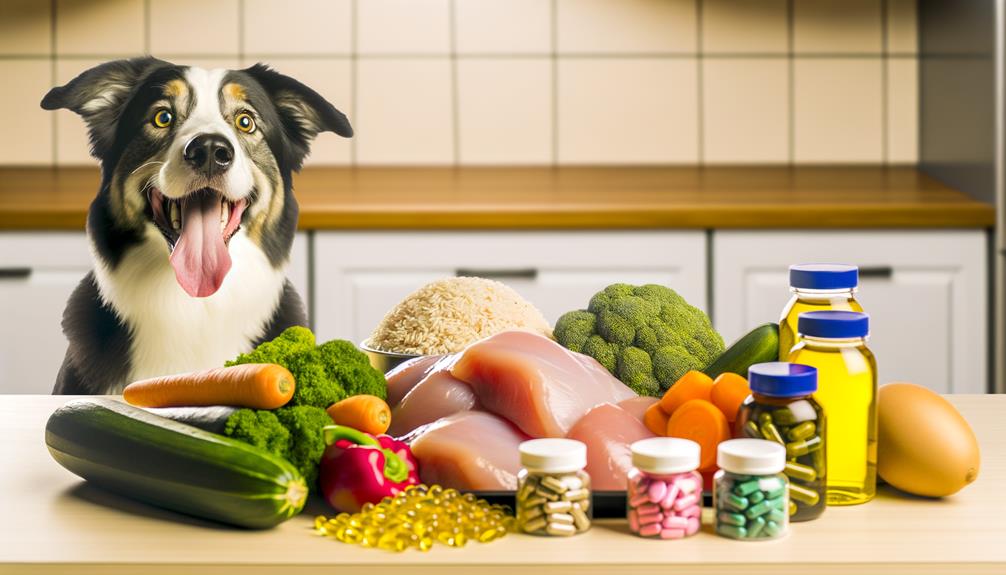
You might be wondering what the key ingredients in dog food are.
We're going to discuss the nutritional content, the importance of proteins, and the role of essential vitamins.
Nutritional Content Analysis
Let's dive into the nutritional content analysis of essential ingredients in dog food, ensuring your pet gets the right balance of nutrients from their chicken-based meals.
A commercial food comparison is essential to understand the nutrient profile of your homemade recipes. This will allow you to assess whether your dog's diet meets or surpasses the nutritional standards set by commercial dog foods.
Keep in mind that dietary restrictions impact the nutritional content of your homemade meals. If your dog is allergic to certain ingredients or has specific dietary needs, you'll need to adjust the recipe accordingly, which can affect the nutrient balance.
Ensuring you're aware of these factors is vital to providing your dog with a healthy, balanced diet.
Importance of Proteins
Protein-packed meals play a vital role in your dog's diet, supporting muscle development and maintaining overall health. The diversity of protein sources in your furry friend's food is equally important. You're not just limited to chicken. Turkey, beef, fish, or even plant-based proteins like lentils can add variety to their diet and provide essential amino acids.
But it's not just about how much protein they're getting; it's also about how well they're absorbing it. Protein absorption rates can vary based on the source and quality of the protein. High-quality proteins are easier for your dog to digest and absorb, meaning they get more nutritional bang for their buck. So, don't just focus on quantity; quality matters too.
Role of Essential Vitamins
While focusing on high-quality proteins for your dog's diet is important, it's also key to not overlook the role that vitamins play in their overall health. Vitamins are essential for various bodily functions, including bone development, vision, and digestion. However, you must be aware of vitamin overdosing risks. Just as deficiencies can cause health issues, an excess of certain vitamins can be harmful.
To provide a balanced diet, ensure a diversity of vitamin sources. This could include chicken liver for vitamin A, eggs for vitamin D, or leafy greens for vitamin K. But remember, it's not about feeding your dog large amounts of these foods, but rather maintaining a balanced and diversified diet. Always consult your vet for personalized advice.
Preparing Chicken Safely for Dogs
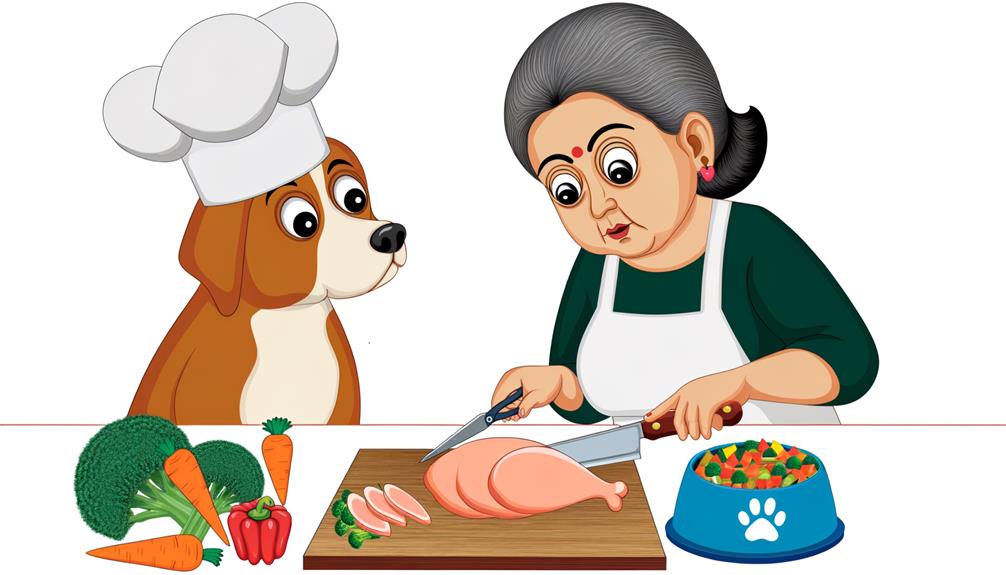
Before you whip up any homemade dog food with chicken, it's crucial to know how to prepare it safely to protect your furry friend from potential health risks. When it comes to chicken sourcing, always opt for high-quality, fresh chicken from reputable suppliers. Don't skimp on quality as it could compromise your dog's health. Remember, your pooch deserves the best!
Next, let's talk about safe defrosting. If you've stored your chicken in the freezer, you must defrost it properly before cooking. Never leave chicken out at room temperature to thaw as this promotes bacterial growth. Instead, move the chicken to the refrigerator and let it defrost slowly. This process could take up to 24 hours, so plan accordingly.
Once the chicken is defrosted, wash your hands and clean your preparation surfaces. Cross-contamination can be a serious issue, so it's best to have a dedicated cutting board and knife for meat preparation. Make sure you thoroughly cook the chicken to kill any potential bacteria. Raw or undercooked chicken can have harmful pathogens like Salmonella or Campylobacter, which can cause serious illness in dogs.
Lastly, avoid seasoning the chicken. Dogs don't need the extra salt or spices that humans do, and some seasonings can even be harmful to them.
Recipe 1: Chicken and Rice Medley
Let's turn our attention to our first recipe: the Chicken and Rice Medley.
You'll start by preparing your ingredients, then move on to the cooking procedure.
It's a simple, nutritious meal your dog is sure to love.
Preparing the Ingredients
First off, gather all your ingredients: fresh chicken, brown rice, peas, carrots, and a bit of olive oil. Ingredient sourcing is important here, you'll want to find high-quality, organic ingredients if possible, it's healthier for your pup. Remember, the fresher the ingredients, the better the taste. Your local farmers' market is an excellent place to start.
Next, let's talk kitchen hygiene. Make sure your work area is squeaky clean before you start. Wash your hands thoroughly, sanitize your cutting board, and sharpen your knives. Rinse the chicken under cold water and pat it dry. Likewise, wash the veggies well. Then, chop the chicken into small, bite-sized pieces, and do the same with the veggies. You're now ready to start cooking!
Cooking Procedure
Now that your ingredients are prepped and your kitchen is sparkling clean, we can get down to the business of cooking your Chicken and Rice Medley. Remember the chicken selection tips? Go for boneless, skinless chicken breasts. Boil them first, then cut into bite-sized pieces. Simultaneously, get your rice on the stove. Cook it until it's soft and easy to digest. Mix the chicken and rice together, ensuring a balanced consistency.
Dealing with leftovers is a breeze. Just refrigerate the unused portion in a sealed container. You can serve it cold, or warm it up a bit if your dog prefers. Remember, fresh is best. Don't keep leftovers for more than three days. Enjoy cooking this healthy meal for your furry friend!
Recipe 2: Chicken and Vegetable Stew
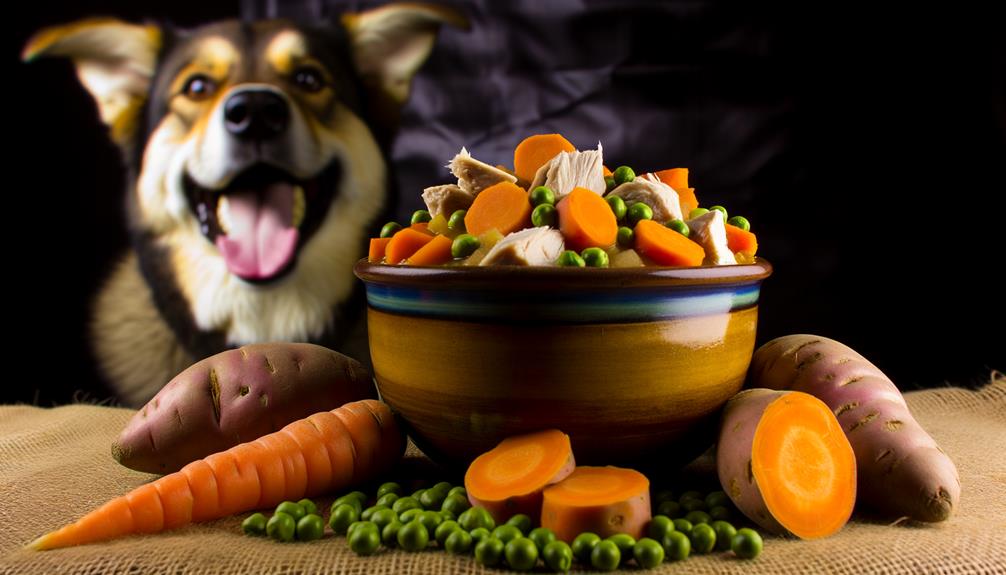
You're about to discover an irresistible chicken and vegetable stew recipe that your dog will absolutely love. This meal is filled with nutritious ingredients and can be easily tweaked with stew variations to suit your dog's specific dietary needs.
Now, let's get started on this delicious feast. You'll need boneless chicken, carrots, peas, and potatoes. Start by boiling the chicken until it's fully cooked. While that's happening, chop your veggies into small, bite-sized pieces. The size ensures your dog can easily digest them. Once the chicken is cooked, remove it from the pot but keep the broth. Shred the chicken into manageable pieces for your furry friend.
Next, add your vegetables to the broth and let them simmer until they're soft. Add the chicken back in and let everything cook together for a few minutes. The result? A hearty, wholesome stew that'll make your dog's tail wag with anticipation.
But let's talk about seasoning safety. Avoid using ingredients like onions, garlic, salt, or spices that could be harmful to dogs. The natural flavors from the chicken and vegetables are more than enough to make this dish tasty and enticing to your pet.
Feel free to experiment with different stew variations. Try adding other dog-safe vegetables like green beans or squash. By adding variety, you're not only keeping your dog's meals exciting but also providing them with a range of nutrients.
In the end, this chicken and vegetable stew recipe isn't just about making your dog's mealtime more enjoyable, it's about giving them a healthy, balanced diet that keeps them happy and hearty.
Recipe 3: Chicken, Sweet Potato and Apple Mix
Switching gears from stews, let's explore a chicken, sweet potato, and apple mix that your canine companion is bound to savor. This recipe isn't only mouthwatering for your furry friend but also packed with nutrients essential for their health.
Let's start with the sweet potato benefits. This orange tuber is a fantastic source of dietary fiber, which aids in digestion and helps maintain a healthy weight. It's also rich in vitamins A, C, and B6, promoting good vision, a strong immune system, and a healthy nervous system. Plus, the high potassium content supports heart health.
Next, let's talk about apple inclusion advantages. The apple provides a crunchy texture that dogs love and is loaded with beneficial nutrients. Apples are a great source of vitamins A and C, helping to maintain your dog's skin, coat, and overall health. They also contain plenty of fiber for smooth digestion, and the natural sugars can give your pet a nice energy boost.
Now, onto the recipe. You'll need a pound of chicken, one sweet potato, and an apple. First, cook the chicken thoroughly and shred it. Peel the sweet potato and apple, then chop them into bite-sized pieces. Boil the sweet potato until it's soft, then mix it with the shredded chicken and apple pieces. Let it cool before serving.
This chicken, sweet potato, and apple mix offers a delightful blend of flavors and textures that will have your dog wagging its tail in delight. It's a wholesome, nutritious meal that you can feel good about serving your best friend.
Recipe 4: Chicken, Quinoa and Pea Feast
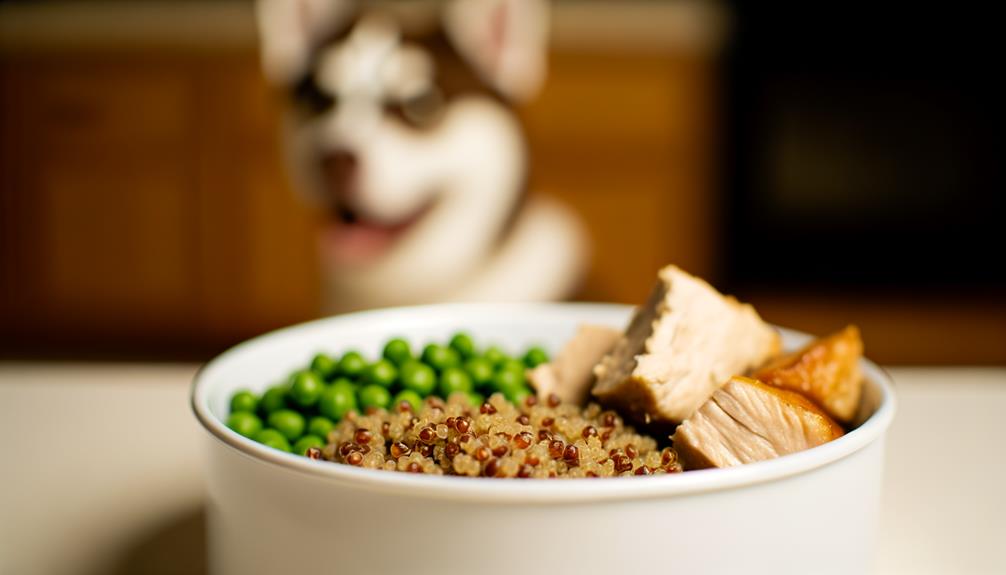
Let's dive into the next recipe, 'Chicken, Quinoa and Pea Feast', a protein-packed, fiber-filled meal that'll keep your dog both healthy and satisfied. This recipe not only tastes great to your furry friend but also provides excellent nutrition.
Quinoa, a 'superfood' often mistaken for a grain, is actually a seed. Its benefits are vast. It's packed with protein, containing all nine essential amino acids, and is especially beneficial for dogs with food allergies or sensitivities due to its hypoallergenic properties. Its high fiber content is excellent for your dog's digestion, ensuring they feel full for longer. Quinoa's rich in iron, magnesium, and B-vitamins too, promoting overall health and vitality.
Pea inclusion is another highlight of this recipe. Peas are a great source of vitamins A, K, and B, along with various minerals like iron, zinc, and magnesium. They're low in fat but high in fiber and protein, aiding in weight management. Peas also offer heart health benefits due to their rich content of lutein, a powerful antioxidant.
To prepare this feast, you'll need chicken, quinoa, peas, and a bit of olive oil. Begin by cooking the chicken thoroughly, then set it aside to cool. Cook your quinoa as per the package instructions. Once ready, mix the chicken and quinoa together, adding in your peas. A drizzle of olive oil will add a touch of healthy fat to enhance your dog's coat shine.
Ensure the meal has cooled completely before serving it to your dog. With the 'Chicken, Quinoa and Pea Feast', you're feeding your pet a balanced diet, packed with protein, fiber, and vital nutrients.
Recipe 5: Chicken and Pumpkin Delight
Moving on to another flavorful dish, 'Chicken and Pumpkin Delight' offers a nutritious blend your dog will surely relish. This recipe combines the protein-rich goodness of chicken with the numerous pumpkin benefits, creating a dish that's not just appetizing but also incredibly healthy for your furry friend.
Sourcing chicken correctly is the key to this recipe. Opt for organic, free-range chicken that's free from hormones and antibiotics. It's not just about the taste, but also about ensuring that your dog gets the cleanest, healthiest protein possible.
Now, let's talk about the pumpkin. One of the pumpkin benefits is its rich fiber content, which aids in the digestive process. It's also a great source of beta-carotene, an antioxidant that's converted into Vitamin A in the body. This boosts your dog's immune system, aids in vision health, and promotes skin and coat health. Furthermore, pumpkin is low in calories, making it an excellent addition for dogs on a weight management diet.
Preparation is simple. Cook the chicken thoroughly, and make sure there are no bones. Puree the pumpkin, then mix it with the chicken. You can add a little bit of chicken broth for extra flavor. Serve it cool.
Remember, balance is key. While 'Chicken and Pumpkin Delight' is a nutritious meal, it's important to provide varied meals to ensure your dog gets a wide range of nutrients. Rotate this dish with other recipes for a balanced diet.
This recipe is a testament to the fact that dog food can be both delicious and nutritious. It's a winning combination of taste, health benefits, and simplicity that your dog will love.
Storing Homemade Dog Food
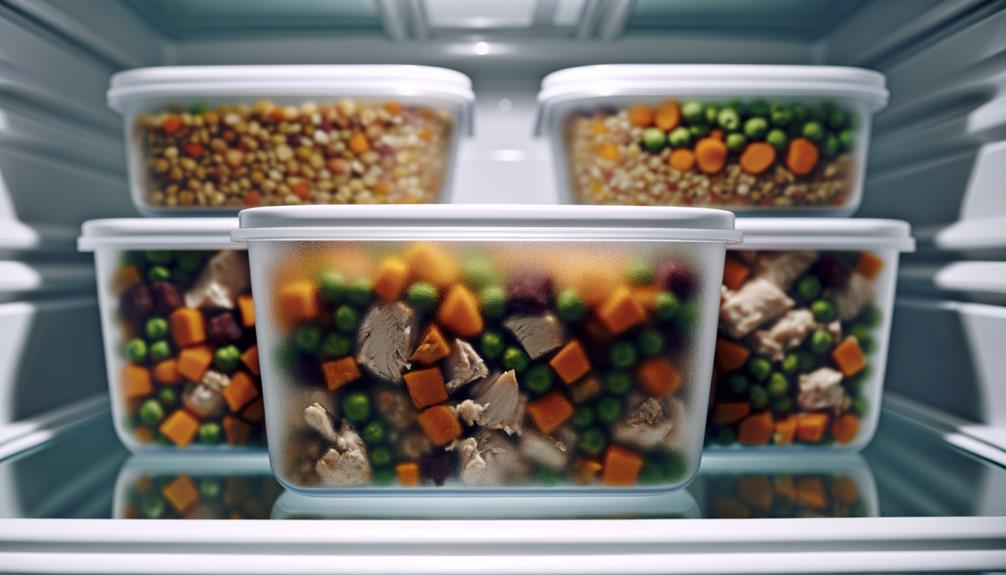
When it comes to preserving the freshness and quality of your homemade dog food, proper storage is crucial. There's a sense of accomplishment when you've made a fresh batch of healthy, nutritious meals for your furry friend. However, the last thing you want is for that food to spoil before your dog gets to enjoy it.
Let's talk about freezing techniques. Freezing is an excellent way to store homemade dog food because it extends the shelf life significantly. You can portion out the meals into individual servings, pop them into freezer-friendly containers or bags, and store them in the freezer. This way, you'll have meals ready to go for your dog, and you won't have to worry about the food going bad. Just remember to defrost meals in the fridge overnight before serving.
Speaking of shelf life, homemade dog food generally has a shorter one compared to commercial options. If you're storing the food in the fridge, it typically lasts 3 to 5 days. Compare this to the months-long shelf life of store-bought food. However, when properly frozen, homemade dog food can last up to 3 months.
Transitioning Your Dog to Homemade Food
Switching your dog to homemade food requires a gradual transition to avoid digestive upset. This process isn't as daunting as it may seem and brings numerous benefits such as food affordability and meal variation.
For food affordability, homemade dog food can be less expensive than commercial options, especially if you buy ingredients in bulk or utilize leftovers from your meals. However, it's important to ensure that those leftovers are safe and nutritious for your dog. You're not just saving money; you're also investing in your dog's health by controlling what goes into their food.
Meal variation can also be a significant advantage of homemade food. Dogs, like humans, enjoy a bit of variety in their diet. By making their food, you can introduce new flavors and textures that can keep mealtime exciting for your furry friend. This can be especially beneficial for picky eaters who may get bored with the same commercial food day in and day out.
Start the transition by adding small amounts of the homemade food to your dog's regular diet. Gradually increase the homemade portion while decreasing the commercial food over a period of about a week. This allows your dog's digestive system to adjust to the new diet slowly. Monitor your dog's reaction to the new food closely. Sudden changes in their stool, behavior, or appetite could be a sign that the transition is going too fast or that something in the new diet doesn't agree with them.
Potential Allergies and Solutions
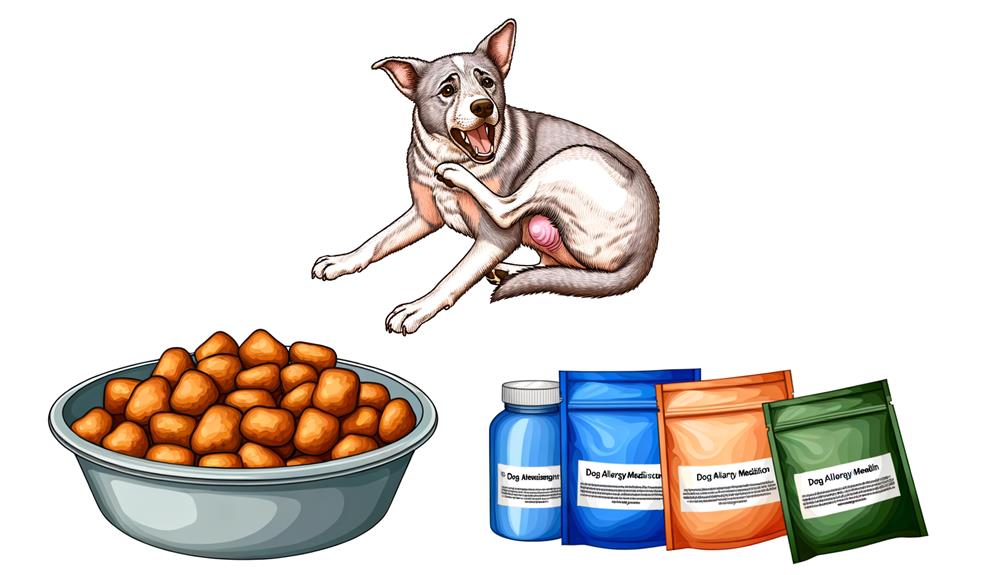
Often, you mightn't be aware that your dog has a food allergy until you start preparing their meals yourself. It's essential to be aware of potential allergies, especially to common ingredients like chicken, to keep your furry friend safe and healthy.
Allergy detection methods can help identify if your dog is allergic to chicken or any other ingredients in your homemade meals. Symptoms to look out for include excessive itching, skin rashes, vomiting, diarrhea, and ear infections. If your dog exhibits any of these symptoms after eating, it's best to consult your vet immediately. They might conduct a food elimination diet or skin tests to pinpoint the allergen.
If your dog is indeed allergic to chicken, don't fret. There are various hypoallergenic alternatives available to replace chicken in your dog's diet. One such option is rabbit meat, which is less likely to cause allergies. Other alternatives include fish, kangaroo, and venison. You could also consider plant-based proteins like lentils or chickpeas, but always consult your vet before making significant changes to your dog's diet.
Remember, each dog's dietary needs and reactions to different foods are unique. So, even if a certain food is generally considered hypoallergenic, it mightn't be the best fit for your pet. Always observe your dog's reactions to new foods and consult your vet regularly.
In the end, your priority is to ensure your dog's meals are nutritious, safe, and enjoyable. Knowing potential allergies and how to work around them is a vital part of this process.
Frequently Asked Questions
Can I Use Turkey Instead of Chicken in These Recipes?
Yes, you can substitute turkey for chicken in these recipes. Consider the turkey's nutritional value; it's comparable to chicken. Just remember, raw turkey may carry bacteria, so it's safer to use cooked turkey.
How Often Should I Rotate These Chicken-Based Recipes?
You should rotate the recipes every week. It'll help maintain nutritional balance and also prevent potential allergy considerations. Keep in mind, variety is crucial for your dog's overall health and well-being.
Are These Chicken Recipes Suitable for Puppies and Older Dogs?
Yes, these recipes are suitable for both puppies and older dogs. However, consider your puppy's nutritional needs and your senior dog's digestion. Adjust portions and ingredients accordingly to ensure they're getting balanced, digestible meals.
What Other Protein Can I Use if My Dog Is Allergic to Chicken?
If your pup's allergic to chicken, don't worry! You can explore alternative proteins like beef, turkey, or fish. Allergy friendly substitutions are key. Consider testing different meats to see what your dog tolerates best.
Can I Freeze These Chicken Dog Food Recipes for Future Use?
Absolutely, you can freeze them! Just ensure you're using proper freezing methods. Divide the food into appropriate portion sizes for your dog before freezing. This makes thawing and serving much easier and quicker for you.
Conclusion
Making your own dog food with chicken can be a rewarding experience. You'll know exactly what they're eating, ensuring it's nutritious and safe.
With recipes like Chicken and Rice Medley or Chicken and Pumpkin Delight, you're providing a delicious, balanced meal. Remember to introduce homemade food gradually and watch for allergies.
By investing this extra care, you're helping to keep your furry friend healthier and happier for years to come.

